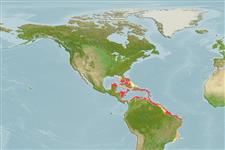Environment: milieu / climate zone / depth range / distribution range
Ecologia
marino associati a barriera corallina; distribuzione batimetrica 0 - 85 m (Ref. 9626), usually 5 - 30 m (Ref. 9626). Tropical; 28°N - 25°S, 91°W - 31°W
Western Atlantic: Bahamas to Brazil, including the southern part of the Gulf of Mexico and throughout the Caribbean Sea.
Size / Peso / Age
Maturity: Lm ? range ? - ? cm
Max length : 37.0 cm TL maschio/sesso non determinato; (Ref. 26340); common length : 30.0 cm TL maschio/sesso non determinato; (Ref. 3815)
Spine dorsali (totale): 12; Raggi dorsali molli (totale): 12; Spine anali 3; Raggi anali molli: 10. Dorsal profile of head moderately steep; prefrontal tubercle not well developed; silvery with a lavender iridescence, the edges of the scales brownish yellow and the centers with a vertically elongate iridescent blue-green or blue spot (Ref. 13442).
Adults often seen over rocky areas or reefs, but also on flat bottoms to about 85 m depth, while the young inhabit shallower waters (Ref. 3815). Feeds on crabs, mollusks, worms, brittle stars and hermit crabs (Ref. 3815). This is the most common species of the genus in the Antilles (Ref. 3815). Important food fish (Ref. 3815).
Life cycle and mating behavior
Maturità | Riproduzione | Deposizione | Uova | Fecundity | Larve
Cervigón, F., 1993. Los peces marinos de Venezuela. Volume 2. Fundación Científica Los Roques, Caracas,Venezuela. 497 p. (Ref. 9626)
IUCN Red List Status (Ref. 130435)
Threat to humans
Reports of ciguatera poisoning (Ref. 30303)
Human uses
Pesca: commerciale
Informazioni ulteriori
Nomi ComuniSinonimiMetabolismoPredatoriEcotossicologiaRiproduzioneMaturitàDeposizioneSpawning aggregationFecundityUovaEgg development
BibliografiaAcquacolturaProfilo di acquacolturaVarietàGeneticaElectrophoresesEreditarietàMalattieElaborazioneNutrientsMass conversion
Strumenti
Special reports
Download XML
Fonti Internet
Estimates based on models
Preferred temperature (Ref.
123201): 25.4 - 28, mean 27.3 °C (based on 212 cells).
Phylogenetic diversity index (Ref.
82804): PD
50 = 0.5001 [Uniqueness, from 0.5 = low to 2.0 = high].
Bayesian length-weight: a=0.01950 (0.01248 - 0.03045), b=2.95 (2.82 - 3.08), in cm total length, based on LWR estimates for this species & Genus-body shape (Ref.
93245).
Trophic level (Ref.
69278): 3.7 ±0.2 se; based on diet studies.
Resilienza (Ref.
120179): Medio, tempo minimo di raddoppiamento della popolazione 1.4 - 4.4 anni (Preliminary K or Fecundity.).
Fishing Vulnerability (Ref.
59153): Low to moderate vulnerability (27 of 100).
Nutrients (Ref.
124155): Calcium = 45.5 [21.0, 91.8] mg/100g; Iron = 0.561 [0.298, 1.114] mg/100g; Protein = 19.3 [18.0, 20.7] %; Omega3 = 0.124 [0.075, 0.208] g/100g; Selenium = 33.9 [17.7, 64.2] μg/100g; VitaminA = 58.9 [14.9, 219.9] μg/100g; Zinc = 0.977 [0.631, 1.411] mg/100g (wet weight);
